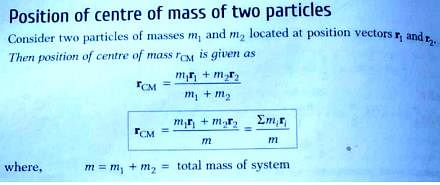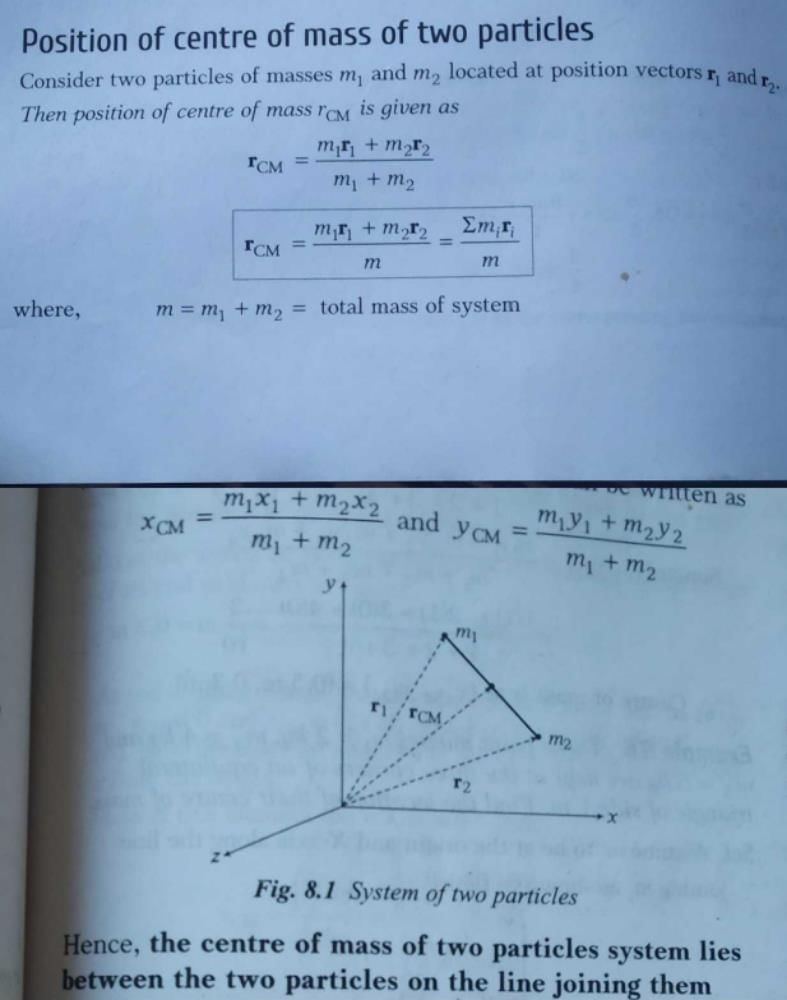Class 11 Exam > Class 11 Questions > The centre of mass of two particles liesa)on ...
Start Learning for Free
The centre of mass of two particles lies
- a)on the line perpendicular to the line joining the particles
- b)on a point outside the line joining the particles
- c)on the line joining the particles.
- d)none of the above
Correct answer is option 'C'. Can you explain this answer?
| FREE This question is part of | Download PDF Attempt this Test |
Verified Answer
The centre of mass of two particles liesa)on the line perpendicular to...


Most Upvoted Answer
The centre of mass of two particles liesa)on the line perpendicular to...

Free Test
FREE
| Start Free Test |
Community Answer
The centre of mass of two particles liesa)on the line perpendicular to...
The center of mass of a system of particles is the point at which the entire mass of the system can be considered to be concentrated. It is a point that simplifies the analysis of the system's motion. The position of the center of mass depends on the distribution of masses within the system.
The center of mass of two particles can be determined by considering the concept of weighted average. The position of each particle is weighted by its mass, and the center of mass is calculated as the average of these positions.
Let's consider two particles with masses m1 and m2, located at positions r1 and r2, respectively.
1. The Line Joining the Particles:
The center of mass of a system of two particles always lies on the line joining the particles. This is because the position of each particle is weighted by its mass, and the center of mass is calculated as the average of these positions. Since the position of each particle is multiplied by its mass, the center of mass will be closer to the particle with greater mass. Therefore, the center of mass will lie on the line joining the particles.
2. Perpendicular Line:
The center of mass does not lie on a line perpendicular to the line joining the particles. If the center of mass were to lie on a line perpendicular to the line joining the particles, it would indicate that the center of mass is equidistant from both particles. However, since the position of each particle is weighted by its mass, the center of mass will be closer to the particle with greater mass. Therefore, it will not be equidistant from both particles, and hence will not lie on a line perpendicular to the line joining the particles.
3. Point Outside the Line Joining the Particles:
The center of mass does not lie outside the line joining the particles. As mentioned earlier, the center of mass is calculated as the average of the positions of the particles, weighted by their masses. This means that the center of mass will always lie between the two particles, closer to the particle with greater mass. Therefore, it will not lie outside the line joining the particles.
In conclusion, the correct answer is option C - the center of mass of two particles lies on the line joining the particles.
The center of mass of two particles can be determined by considering the concept of weighted average. The position of each particle is weighted by its mass, and the center of mass is calculated as the average of these positions.
Let's consider two particles with masses m1 and m2, located at positions r1 and r2, respectively.
1. The Line Joining the Particles:
The center of mass of a system of two particles always lies on the line joining the particles. This is because the position of each particle is weighted by its mass, and the center of mass is calculated as the average of these positions. Since the position of each particle is multiplied by its mass, the center of mass will be closer to the particle with greater mass. Therefore, the center of mass will lie on the line joining the particles.
2. Perpendicular Line:
The center of mass does not lie on a line perpendicular to the line joining the particles. If the center of mass were to lie on a line perpendicular to the line joining the particles, it would indicate that the center of mass is equidistant from both particles. However, since the position of each particle is weighted by its mass, the center of mass will be closer to the particle with greater mass. Therefore, it will not be equidistant from both particles, and hence will not lie on a line perpendicular to the line joining the particles.
3. Point Outside the Line Joining the Particles:
The center of mass does not lie outside the line joining the particles. As mentioned earlier, the center of mass is calculated as the average of the positions of the particles, weighted by their masses. This means that the center of mass will always lie between the two particles, closer to the particle with greater mass. Therefore, it will not lie outside the line joining the particles.
In conclusion, the correct answer is option C - the center of mass of two particles lies on the line joining the particles.
Attention Class 11 Students!
To make sure you are not studying endlessly, EduRev has designed Class 11 study material, with Structured Courses, Videos, & Test Series. Plus get personalized analysis, doubt solving and improvement plans to achieve a great score in Class 11.

|
Explore Courses for Class 11 exam
|

|
Similar Class 11 Doubts
The centre of mass of two particles liesa)on the line perpendicular to the line joining the particlesb)on a point outside the line joining the particlesc)on the line joining the particles.d)none of the aboveCorrect answer is option 'C'. Can you explain this answer?
Question Description
The centre of mass of two particles liesa)on the line perpendicular to the line joining the particlesb)on a point outside the line joining the particlesc)on the line joining the particles.d)none of the aboveCorrect answer is option 'C'. Can you explain this answer? for Class 11 2024 is part of Class 11 preparation. The Question and answers have been prepared according to the Class 11 exam syllabus. Information about The centre of mass of two particles liesa)on the line perpendicular to the line joining the particlesb)on a point outside the line joining the particlesc)on the line joining the particles.d)none of the aboveCorrect answer is option 'C'. Can you explain this answer? covers all topics & solutions for Class 11 2024 Exam. Find important definitions, questions, meanings, examples, exercises and tests below for The centre of mass of two particles liesa)on the line perpendicular to the line joining the particlesb)on a point outside the line joining the particlesc)on the line joining the particles.d)none of the aboveCorrect answer is option 'C'. Can you explain this answer?.
The centre of mass of two particles liesa)on the line perpendicular to the line joining the particlesb)on a point outside the line joining the particlesc)on the line joining the particles.d)none of the aboveCorrect answer is option 'C'. Can you explain this answer? for Class 11 2024 is part of Class 11 preparation. The Question and answers have been prepared according to the Class 11 exam syllabus. Information about The centre of mass of two particles liesa)on the line perpendicular to the line joining the particlesb)on a point outside the line joining the particlesc)on the line joining the particles.d)none of the aboveCorrect answer is option 'C'. Can you explain this answer? covers all topics & solutions for Class 11 2024 Exam. Find important definitions, questions, meanings, examples, exercises and tests below for The centre of mass of two particles liesa)on the line perpendicular to the line joining the particlesb)on a point outside the line joining the particlesc)on the line joining the particles.d)none of the aboveCorrect answer is option 'C'. Can you explain this answer?.
Solutions for The centre of mass of two particles liesa)on the line perpendicular to the line joining the particlesb)on a point outside the line joining the particlesc)on the line joining the particles.d)none of the aboveCorrect answer is option 'C'. Can you explain this answer? in English & in Hindi are available as part of our courses for Class 11.
Download more important topics, notes, lectures and mock test series for Class 11 Exam by signing up for free.
Here you can find the meaning of The centre of mass of two particles liesa)on the line perpendicular to the line joining the particlesb)on a point outside the line joining the particlesc)on the line joining the particles.d)none of the aboveCorrect answer is option 'C'. Can you explain this answer? defined & explained in the simplest way possible. Besides giving the explanation of
The centre of mass of two particles liesa)on the line perpendicular to the line joining the particlesb)on a point outside the line joining the particlesc)on the line joining the particles.d)none of the aboveCorrect answer is option 'C'. Can you explain this answer?, a detailed solution for The centre of mass of two particles liesa)on the line perpendicular to the line joining the particlesb)on a point outside the line joining the particlesc)on the line joining the particles.d)none of the aboveCorrect answer is option 'C'. Can you explain this answer? has been provided alongside types of The centre of mass of two particles liesa)on the line perpendicular to the line joining the particlesb)on a point outside the line joining the particlesc)on the line joining the particles.d)none of the aboveCorrect answer is option 'C'. Can you explain this answer? theory, EduRev gives you an
ample number of questions to practice The centre of mass of two particles liesa)on the line perpendicular to the line joining the particlesb)on a point outside the line joining the particlesc)on the line joining the particles.d)none of the aboveCorrect answer is option 'C'. Can you explain this answer? tests, examples and also practice Class 11 tests.

|
Explore Courses for Class 11 exam
|

|
Suggested Free Tests
Signup for Free!
Signup to see your scores go up within 7 days! Learn & Practice with 1000+ FREE Notes, Videos & Tests.
























